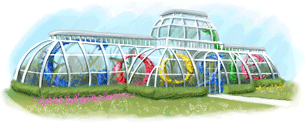- Plea from taxonomist to nutritionists and food people: use scientific names and get them right.
- Cooking writer doesn’t get the hint.
- New Scientist rounds up bunch of recent animal domestication studies.
- DIY bio-char; Muck & Mystery has some ideas.
- Diverseeds has videos of diverse seeds.
- “For one week, 2500 people from Noirmoutier use all their might to harvest this precious La Bonnotte potato by hand.”
- Barcoding bananas: useful for field genebanks?
A.B. Chapman Lectures in Animal Breeding and Genetics
I’m informed by DAD-Net that the A.B. Chapman Lectures in Animal Breeding and Genetics have been presented annually at the University of Wisconsis-Madison since 1994 by leading international scholars in the genetic improvement of animals, and that this year’s lectures were given by Prof. Miguel Angel Toro, Departamento de Produccion Animal, Universidad Politecnica de Madrid, Spain, on May 4 and 5. Prof. Toro gave two talks, on “Principles of Conservation of Animal Genetic Resources” and on “Mating Allocation in Genomic Selection.” Did anyone out there see them, in particular the first, either in person or live on the internet? Let us know. In any case, it looks like they’ll eventually be available for downloading.
Happy Birthday Kew

How many botanic gardens get such vast quantities of Google love? Or a birthday visit from the Queen of England? Kudos to Kew.
Nibbles: Asparagus, Eels, ICT, Dingoes, Phoenix dactylifera, Apples, Bear-pit
- Liguria’s asparago violetto gets Slow Food treatment.
- “The bottom line is we just don’t know why they are struggling so badly.”
- Using mobile phones to treat plant pests and diseases in Uganda.
- Dingoes have positive effect on biodiversity.
- Date palm genome mapped.
- Boffins see the light, explain negative effect of fertilizers on biodiversity.
- Brogdale situation “better,” but for how long?
- Wait, Bern has a bear-pit?
Botanical garden database heaven
An email alert from the good folks at Botanical Gardens Conservation International (BCGI) tells me they have spruced up their website. And the website in turns reminds me that May 18th is Plant Conservation Day, and we should probably do something about that here.
But the main reason for the alert is to draw our attention to two online databases: PlantSearch and GardenSearch.
PlantSearch enables users to locate rare or threatened plant species in cultivation around the world. This database is compiled from lists of living collections submitted to BGCI by the world’s botanic gardens. The database presently includes over 575,000 records representing almost 180,000 taxa from 692 gardens.
And you can find a garden anywhere in the world using GardenSearch, with over 2658 records. We’re working on an interactive botanic garden mapping tool too…
There’s a filter for crop wild relatives. Seems to me the botanical gardens community may be a bit further down the road out of database hell than the world’s genebanks.